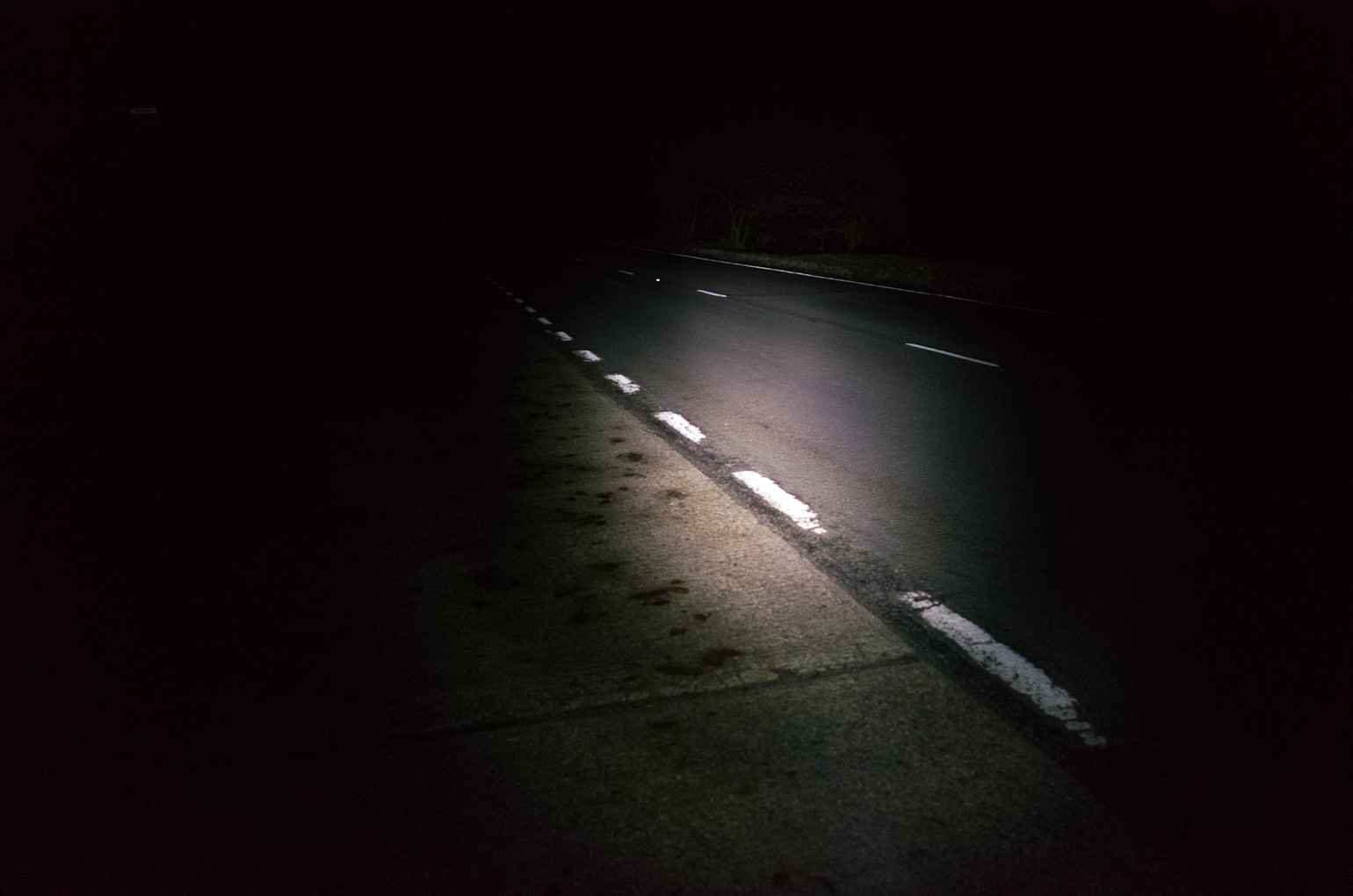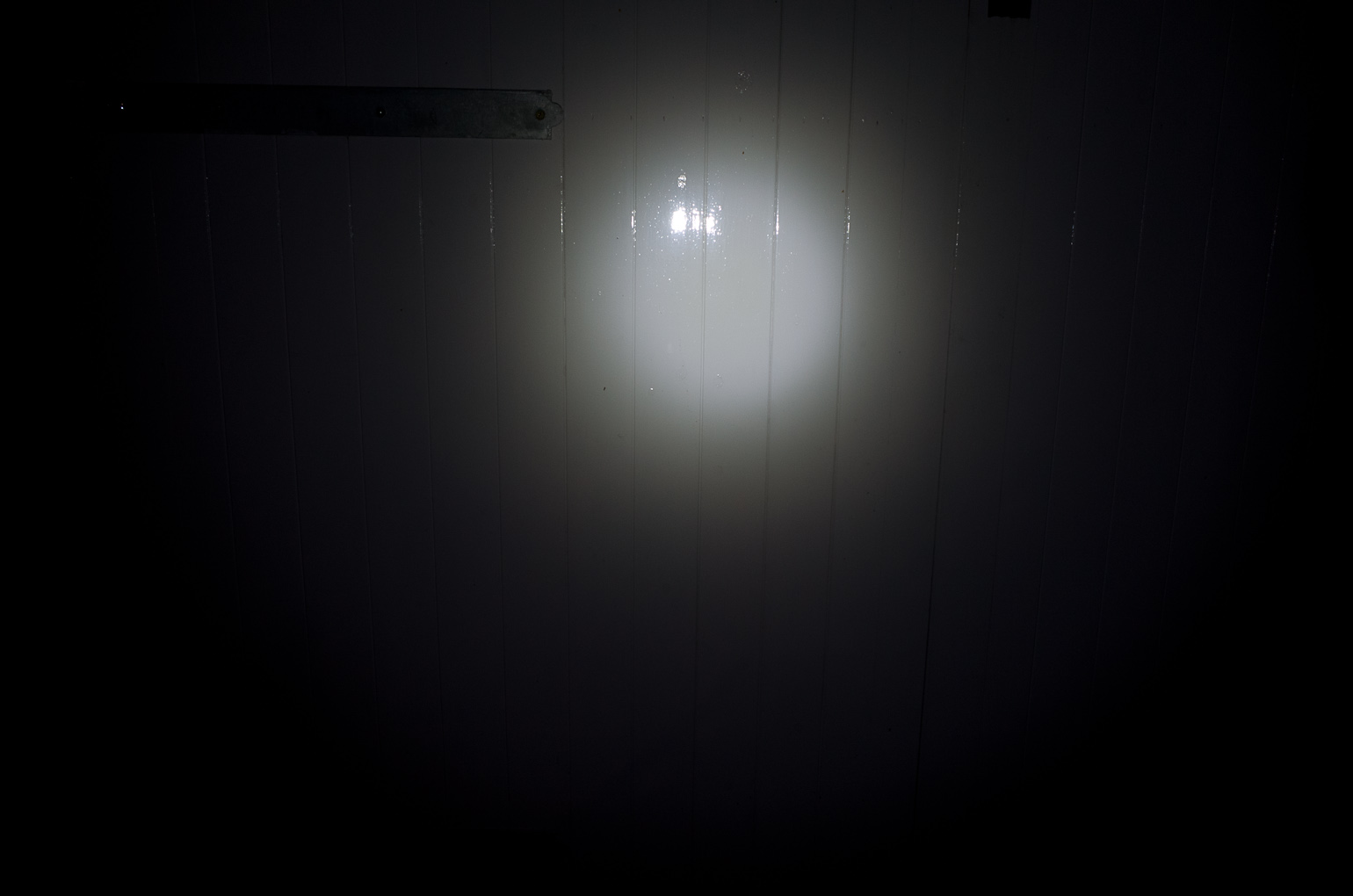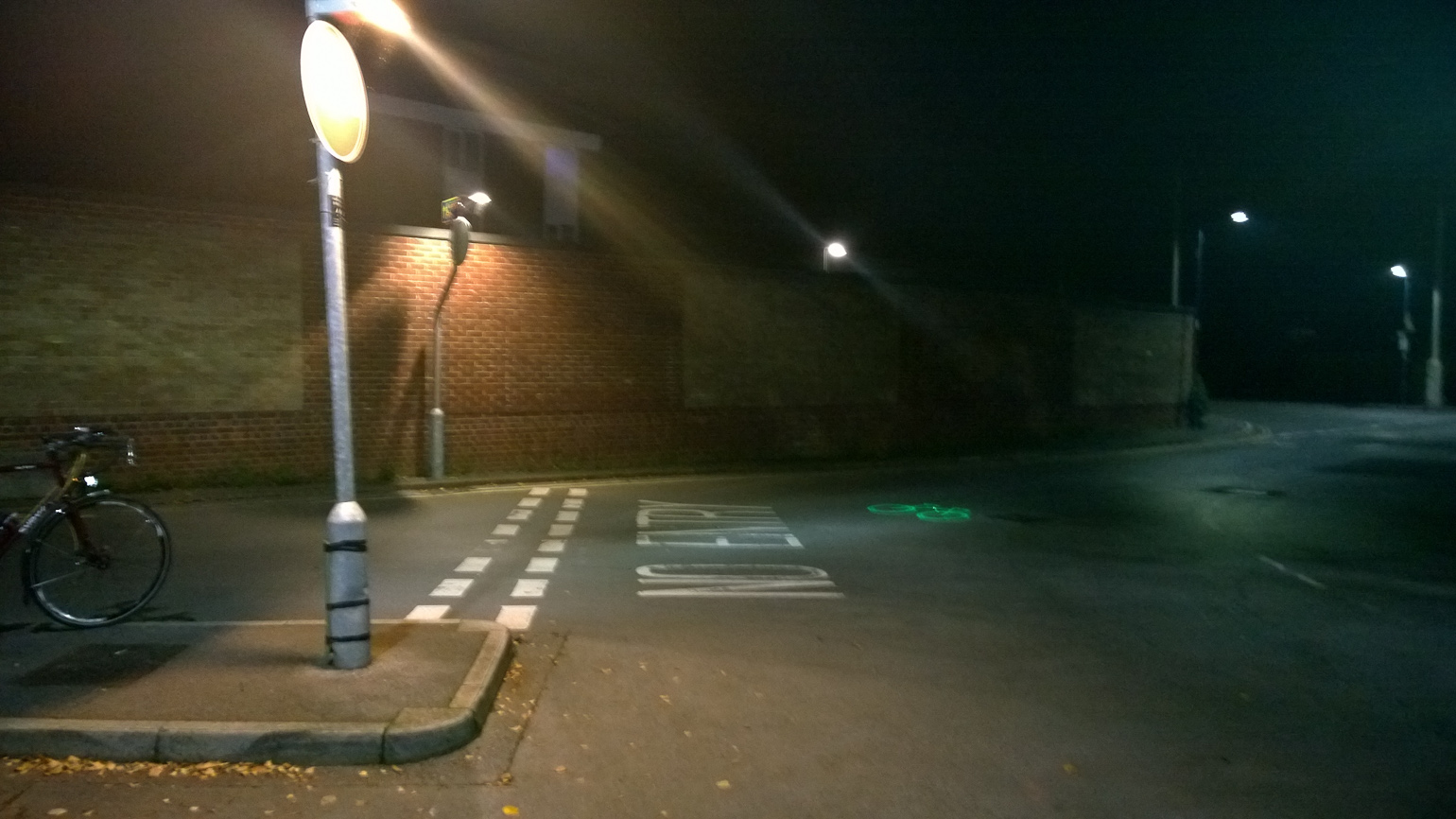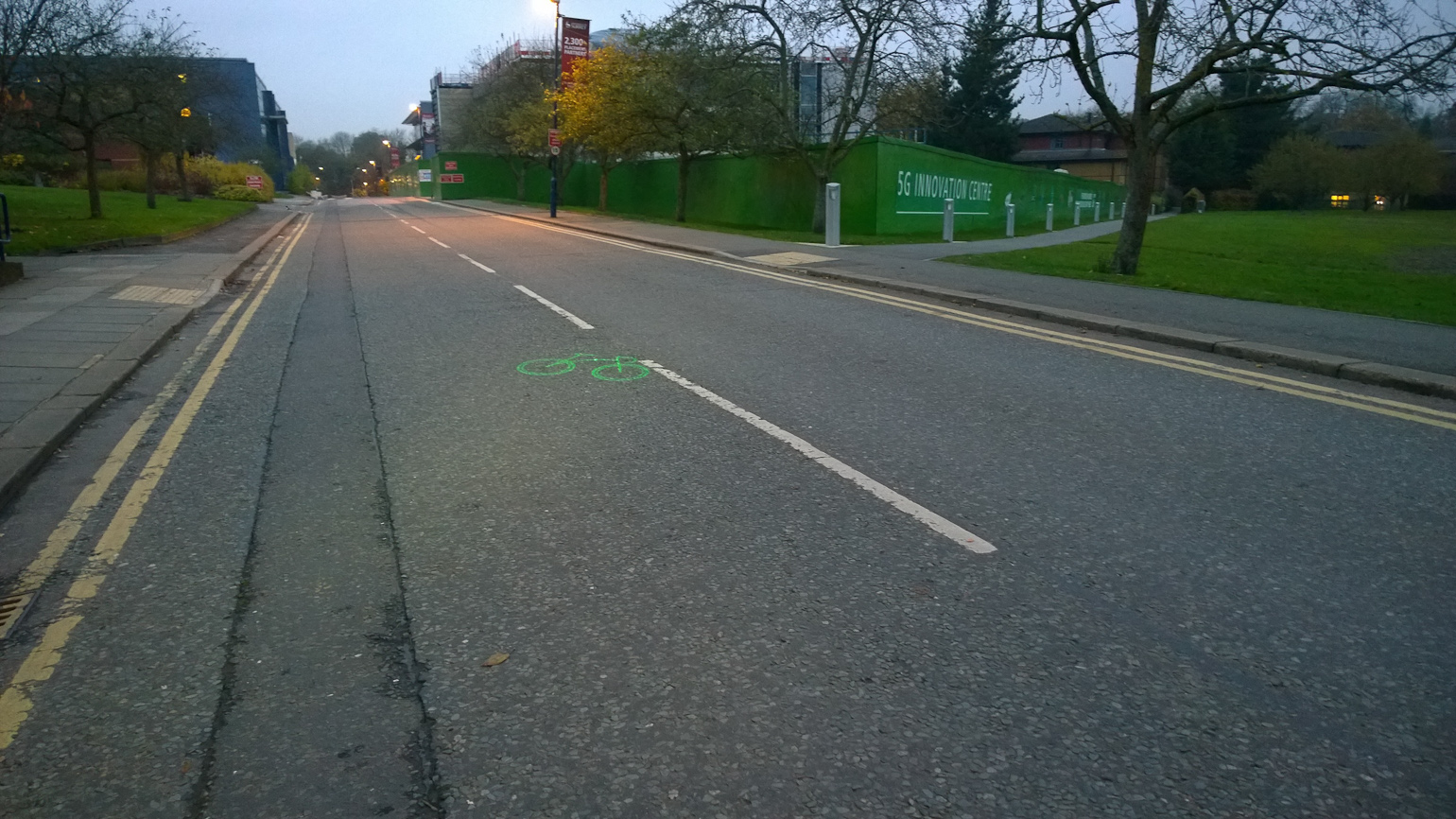First, a confession: I’m a grumpy git when it comes to lights.
I’ve often remarked on Twitter that I’m not a fan of Gimmicky Lights. Sometimes it seems that Kickstarter is awash with myriad madcap ideas as to how photons might save one’s life.
I’m a big fan of lights, but I mainly like what I (grumpily) consider “proper” lights: those which have a properly shaped beam like that of a car, and a constant, bright output. Lights that are good enough to ride dark rural roads at speed but won’t dazzle other road users despite being perfectly visible to them. So grumpy about lighting am I that the only time I ever use a flashing light is as a secondary rear in thick fog.
(That said, I should make it clear that I don’t ride in the wildly illuminated maelstrom of traffic in central London, where such screams for attention may be more justified.)
I am, however, curious—if sceptical, both in the scientific and cynical sense of the word—about anything which might make for reduced risk on the road. Many of the novelty acts paraded on Kickstarter clearly have little hope of doing that; but some do, and some have subsequently attracted credible positive feedback from their users (as opposed to simply positive feedback: confirmation bias can be quite the thing when you’ve taken a £50-100 punt on backing an unfinished product).
One of these more credible lights is the Blaze Laserlight. So when they offered to lend me one to test for a while, I thought, “why not?”
The concept
The Blaze Laserlight has two lights. One is a fairly ordinary high-output LED that kicks out up to a claimed 300 lumens of white light, but the other is—of course—a laser. It’s much like the laser pens people use for Powerpoint presentations, but instead of focusing its light on a dot it projects a green bicycle symbol onto the road ahead. Don’t worry, it’s safe for retinas: you won’t accidentally blind your kids and you certainly won’t be blasting holes through people’s tyres (though if you lurk on Kickstarter for long enough I’m sure something will crop up).
The Blaze light interested me where most other Gimmicky Lights didn’t, for two reasons. Firstly, Blaze do seem to be down with the concept of actual research rather than just that of marketing, as evidenced by their support of The Near Miss Project. Secondly, it’s possible to envisage potential means by which it could help: if a driver is looking at the road rather than the cyclist and happens to see the projected bike symbol, perhaps they could respond—somehow—as a result.
The competition
First, let’s deal with the bit that you see before even getting your hands on a Blaze Laserlight: the price. £125 is a fair old sum, but then a lot of bike lights aren’t cheap.
Perhaps the most appropriate lights to which to compare the Blaze—laser aside—are the Lezyne units, which have broadly comparable outputs and runtimes and (online) prices that range from around half that of the Blaze (for the Power Drive XL and Super Drive XL) to a few quid above it (in the case of the Mega Drive).
I don’t have any Lezyne lights to use in a back-to-back test, but I do have Exposure Joystick and a number of Busch & Müller dynamo lights, which come in at about the same price as the Blaze (if you include a Shimano-based wheel plus, say, a Cyo Premium or Luxos B in the dyno option). I tested these all together on the same bike, so it’s possible to make some direct comparisons, which I’ll come to later. (I ended up testing the lights on a bike with a Luxos U, but its beam is comparable to those of the Cyo Premium and Luxos B.)
It’s worth noting that the battery lights mentioned above have accessories available, including helmet mounts and external batteries; no such accessories are available for the Blaze and the design doesn’t really support them as future enhancements either (the same can be said of the dyno lights, though of course they don’t need external batteries). Not really an issue for most people, though, I suspect.
What’s in the box?
In the box you get the light, its “smart bracket” (to which the light must be mounted in order for the laser and the 300lm mode to be enabled), three bands to allow mounting on a variety of handlebar diameters, an allen key which adjusts both bolts on the bracket, a proprietary charging lead and a small instruction booklet.
The aesthetics are distinctive: the light’s aluminium body is a textured silver, the steel bracket a slightly different matte silver finish, and the rubber parts are a sort of dentist’s-overalls green. Aesthetics are a subjective matter: I’m a little ambivalent about its looks, but there’s no getting away from the fact that the appearance and general feel do quite firmly say high quality. It feels robust and has a reassuring heft.
Setting up
The first task with the Laserlight is to charge it up. The charging lead goes into any old full-size USB port at one end, but the light’s connection is via a two-pole magnetic connector. It’s a curious design decision. It helps make the Laserlight waterproof to the point of being submersible, but then one wonders why a bike light needs to be submersible. Standard ports with rubber covers, as used by other manufacturers, are plenty good enough for the heaviest of rain; indeed Garmin claim their ports are additionally fully sealed internally.
Of course, this proprietary connection means you can’t just grab any old USB lead when you need to feed the light. For commuting this feels particularly awkward, since you may well have reason to charge it at work as well as home. You might want to make sure you carry your lead with you.
Note also that although the magnetic contact is quite firm, it’s not that hard to separate: you wouldn’t be able to use a battery pack to charge this light in a holdall, for instance; nor whilst riding. Admittedly, mostly not a big deal, but it’s another aspect that makes you wonder whether the magnets were worth it.
So, for my money I’d prefer a rubber bung and a standard port; but others may not care, and indeed some may like the bijou novelty of the magnetic connector.
Charging done, the next step is to get it on the bike and pointing in the right direction. Quite a straightforward task: select the appropriate band and bolt the clamp to the bars. Drop the light in and then it’s a case of aiming it. Blaze recommend projecting the bike symbol about half a bus length in front of you. Then, just do up the bolt and you’re off.
It should be noted, of course, that as with just about any twin-lamp unit (for example, the Exposure Strada), you can’t independently adjust the pitch or yaw of the two beams. The recommended positioning of the laser results in a main beam that fires fairly close to horizontal, which may not be to everyone’s taste. Beam shots are included later.
General operation
The operation of the light is reasonably simple. There are two buttons; one for the light and one for the laser. The light button cycles its modes through four modes: flashing, 100lm, 300lm and off, in that order. Note that in order to switch it on you always have to go via the flashing mode; whilst dimming from 300 to 100lm involves going via both off and flashing, which means you probably don’t want to do it while riding. The laser button cycles through three modes: flashing, on and off. For some reason, the light must be on before the laser can be activated (though once the laser’s on it’s possible to turn the light off), but apart from that they’re independently operable.
The buttons themselves are smooth and flush, which gives them a certain aesthetic, but when setting off in the dark with gloves on you do miss the lack of a tactile interface. This lack of tactility reinforced my reluctance to change modes on the move.
Once set, of course, it just sits there while you ride. It’s at its most stable when fitted to a larger-diameter bar: when using the thinnest rubber band it’s rock solid; the medium band is adequately stable, but the 4mm of rubber in the thickest band (used for a 22.2mm bar, ie when mounting away from the stem on a flat bar, or on an extension bracket) means the projected bike symbol bounces around a fair bit and becomes rather less distinct. That said, this instability isn’t an issue with regard to the main white beam and few people will need to use the thickest band anyway.
The beam
I did capture some beam shots, but I’ll summarise the beams qualitatively first. In fact, I’m reluctant to include beam shots at all. It may be true that “the camera never lies”, but it certainly has a much different response to the human eye. These images are at best only slightly representative of the full beams, and this is particularly true of the Luxos’s beam, which is of a radically different shape and distribution, and is much harder to compare to the symmetric-beamed Blaze and Exposure.
So…
The Blaze and the Joystick are fairly easy to compare, as both have a radially symmetric beam. The Blaze’s beam has a much broader distribution and, as a result of that and its lower total output, is less intense. The Joystick is designed to work as both a bar light and a helmet light and so is designed with a narrower beam. This makes it better for seeing ahead at high speed, but it gives much less peripheral illumination and also means it’s rather a dazzler when it ends up pointing at someone. I’ve used the Joystick (and an older 240lm version of it) on the road before, and drivers really don’t like it.
Of particular note is the evenness of the Blaze’s beam. It does have a brighter central area, but the falloff around its edge is smooth; the whole beam is virtually artifact-free. It’s actually a very effective beam: good enough to provide plenty of breadth at low speed but still just about good enough for 30-35km/h away from street lighting. If you’re going faster, that’s when it starts feeling a little weak in comparison to the beams of both the B&M and the Exposure.
Here are some open-road sample shots of the beams of the three lights I tested, all shot at identical sensitivity, aperture and shutter speed. The road was dry and well away from street lighting.
First, the Blaze: laser only, and then the laser with the 100lm and 300lm modes.
Next, the Exposure Joystick (mk. 7) in 400lm mode (which gives the same runtime as the Blaze’s 300lm mode without the laser).
And finally the Busch & Müller Luxos U, in its standard mode (ie with the “floodlight” turned off). The view here is different because, naturally, this one needs to be on the move to be fully illuminated. Note, also, that there’s no pale concrete in the view, which doesn’t do it any favours in terms of comparison.
As a less realistic but perhaps more controlled test, I repeated the procedure with the lights pointing at a garage door.
In these shots, the lights are still mounted to the bike, and the camera is rigidly mounted to it as well, so the relative positions of the beams in the frame are representative of where they point on the road.
First, the Blaze, in laser-only, 100lm and 300lm modes.
Next, the Joystick in 400lm mode.
And finally the Luxos U. This is where you get to see its shaped beam: it gets roughly as bright as the Joystick close to the horizon, has better horizontal spread than both lights, and falls off in the nearfield so as to give even illumination once the light gets back to your eyes. Note also that its beam is much lower in the picture, ie it’s not shining too much light up into drivers’ eyes.
As an urban light
The main demand of an urban light is probably to be seen, followed by being able to fill in sufficiently through parks and dimly-lit areas so as to be able to cruise at 20-25km/h. This is a pretty easily achievable aim for a light and the Laserlight unsurprisingly delivers.
I wasn’t main-beamed by any drivers while using the light in urban areas, suggesting it may not dazzle excessively in a streetlit environment.
I remain wedded to the Busch & Müller Lyt as a main urban light; but the Blaze is definitely very good.
As a light for the open road
With its broad beam, and its pitch reliant on the positioning of the laser projection, I didn’t expect to be impressed by the Blaze light on dark, rural roads. But I was pleasantly surprised.
It’s not powerful enough to go full tilt down potholed hills with confidence, but—in the dry at least—it’s good enough to tick along at a good enough pace. I reserve judgment on whether it dazzles: I didn’t get main-beamed by any drivers during my test, but I’d need to use it a little longer to be confident. I’d also like to see its rural performance on wet roads, where more light tends to be lost forwards and less reflected back into the rider’s eyes.
Overall, there’s a good balance between throw and spread for a simple conical beam. It makes an adequate rural light with the caveat that you’re limited to a 3hr run time (assuming you use the 300lm mode; the 100lm mode isn’t really up to “see by” use) with no possibility of charging on the fly. Personally—and I suspect I’m not alone—I couldn’t put up with staring at a green bicycle symbol in front of me on the dark open road, so I turned it off and left it for urban areas. (Also, there’s a subtle high-pitched sound that emanates from the laser; absolutely undetectable in an urban soundscape but audible on deserted country lanes.)
Personally, I remain a devoted fan of shaped beams such as those of the Luxos and Cyo, but the Blaze light did at least qualify as a light which—if dazzling did turn out not to be an issue—I’d be willing to use. As a road light, its beam makes it a better all-round performer than the Joystick despite its lesser output.
As a laser beam
Enough of the “see by” light. How’s the “be seen” laser?
I have to start on a low note: At the start of my test week I was pretty unimpressed by the laser’s performance. There was one simple reason for it: wet roads.
At first, I just didn’t find the green symbol was very visible. Not only did it vanish from many angles in the wet, it was also easily trumped by street lighting. Testing it when the town’s Christmas lights are up was perhaps unfair, though the festive decorations in a small rural town don’t come close to the illumination of London’s West End.
The following two shots illustrate the wet road problem. They were taken at the same time of day to within a few minutes (just before sunrise with full cloud cover); in the first, the road is dry and in the second it is moderately wet.
What happens, unsurprisingly, is that the projected light doesn’t scatter but reflects off the water. So if you’re looking head-on at the light, you get a decent view.
But then, of course, you’re staring straight at a light; so the laser isn’t really adding anything here.
The following picture shows quite clearly that once you’re more than just a few degrees off-axis on wet roads, visibility of the symbol is hugely reduced.
Here are a couple of shots in full night, under moderate lighting, which again show the difference in lateral visibility. The first is dry, the second wet.
But, moving on from the wet road performance, the dry road performance is pretty good.
So, despite my initial disappointment, I was more impressed as the week progressed. In the dry, the symbol can be very clear.
Even in partial daylight it can be quite noticeable. The following shot shows the view from roughly where a driver would be with the cyclist to his/hear immediate nearside (ie where they would need to perform a shoulder check in order to see the cyclist). Naturally, there would be a windscreen and dashboard affecting this view, but you get the idea.
The following is a rough approximation of what you might see if the Blaze was approaching from the side (in the dry).
So, the laser performs well in the dry. But it’s not much use in the wet. And its efficacy ebbs and flows quite markedly as the street lighting changes. But is it worth having for the (many) dry days of the year?
Does it make a difference?
Tricky question, of course, especially with just a week’s testing.
Blaze illustrate four scenarios on their site: a cyclist alongside a bus/lorry; a cyclist approaching a minor road from which a driver intends to pull out; a cyclist approaching a pedestrian about to step off the pavement; and a driver pulling back in front of a cyclist after overtaking.
These all seem plausible cases, with the possible exception of the fourth (see below). To my mind, the first and third are where the Laserlight may have the greatest potential.
It’s noteworthy that pedestrians seemed to react to the light much more than drivers; at least, I observed some change in behaviour, even if it was just a turn of the head. In a pedestrian-heavy environment such as central London or a shared path, the laser clearly has great potential to act as a silent advance warning, effective on even the most loudly-earphoned pedestrian. If you use shared cycling/walking infrastructure a lot then I think the Laserlight is an interesting proposition.
Perhaps the light would have potential, if only very little, to present some visibility to the drivers who overtake on approach to a junction, braking as they pass and moving back across without realising that they never actually passed. I wonder, however, whether by that point it’s all a fait accompli and the driver will just move across anyway, especially if there is an oncoming vehicle. It all seems a bit optimistic.
I assume the “passing under braking” case is the fourth scenario offered by Blaze, since the more common pass (at least on rural roads) sees the vehicle accelerating or keeping a steady, significantly faster, speed once past, and moving across is not an issue. Indeed, many rural passes are misjudged such that the driver is still moving out as they pass, rather than back in too soon. The real danger is being hit from behind, and of course the Blaze has no hope of providing a benefit here.
Summary
As a common or garden light, I think it’s a solid performer if the battery life is sufficient for your needs. It’s well suited to an urban environment and surprisingly passable on the open road. In the latter use, the magnetic charging and the low-tactility buttons are questionable design choices that would put me off, but for many urban commuters these will be non-issues.
Of course, the price is well above its performance in terms of the white light alone, so the only reason to buy a Blaze Laserlight is the laser.
The big question is: Will it make you safer?
I think there’s a sort of short, if not massively useful, answer: Perhaps. I think there are scenarios where—even if it didn’t make a real difference often—it’s quite feasible that just one time it could.
What I wonder, however, is just how often that would be. For a start it depends on where and how you ride: if you’re the type who undertakes moving traffic, it might help (but then, hey, you could just not do that); and if you ride where pedestrians stepping into your path would cause you to be at risk (whether by colliding with them or by having to swerve out when a passing vehicle may be approaching from behind) then it may help here too. In fact I personally think that’s the one area where it has real value. But it also depends on the conditions in which you ride: the laser projection doesn’t really work in daylight, nor reliably in low light; it pretty much doesn’t work at all when the roads are wet, and it can be overwhelmed by strong street lighting.
But, despite all these reservations, I did warm to the light. It didn’t make me feel safer; it didn’t make me feel I needed it; but it did make me think that there were situations—even though they were situations I don’t routinely experience myself—where it could actually work.
Despite being an outstandingly well-made piece of kit with good all-round performance, it’s not for me. I don’t think it addresses any risks I encounter and I like my dyno lights, even in town. But, as long as you can accept its inevitable shortcomings rather than treating it as some sort of magic shield, it could be for you.























